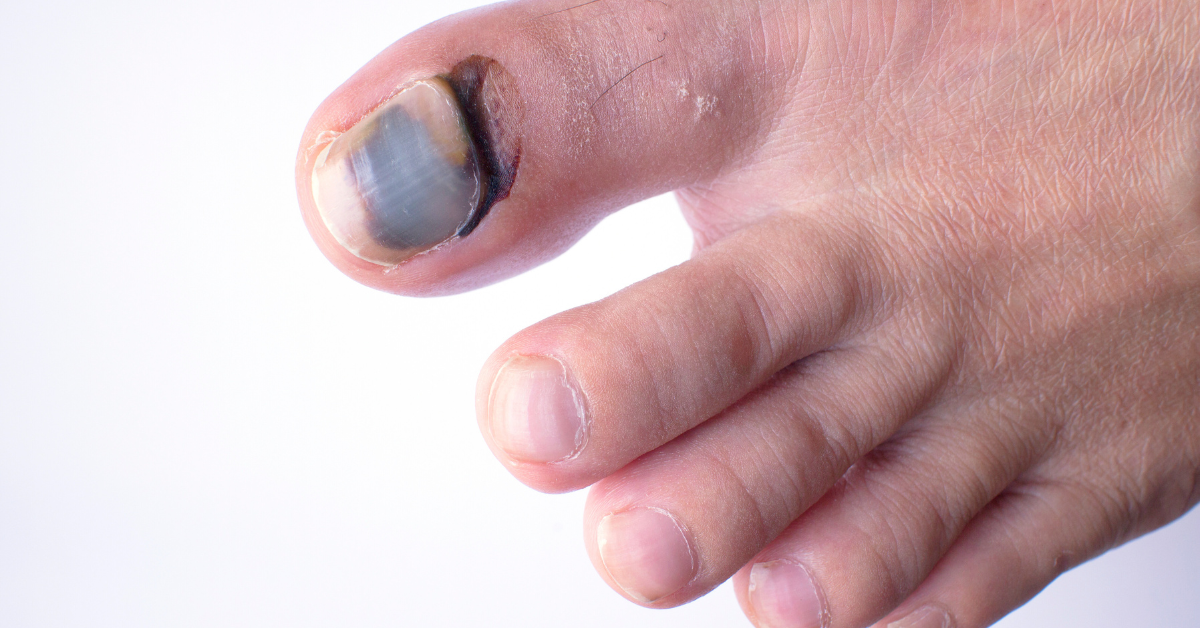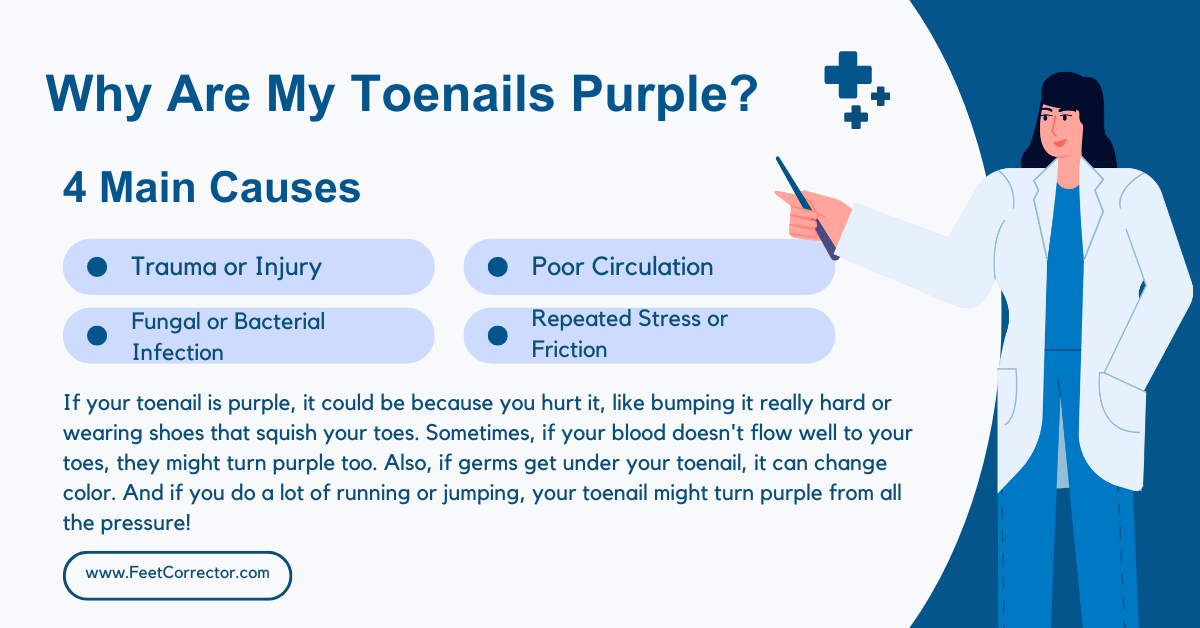Why Are My Toenails Purple?

Experiencing the shock of purple toenails can often spark curiosity and concern. If you’ve noticed your toenails turning purple underneath, at the cuticle, or appearing light purple, you’re likely seeking answers. This comprehensive guide aims to simplify purple toenails, outlining their various causes, diagnosis methods, treatments, and preventive measures.
Causes of Purple Toenails
Purple toenails can indicate underlying issues that range from benign to potentially serious. Understanding the root causes is crucial for proper management.
Here’s a detailed look at some common triggers:
Footwear-Related Causes
- The type of shoes you wear plays a significant role in toenail health. Tight or ill-fitting shoes can exert pressure on the toes, leading to bruising or injury that manifests as purple toenails. If your toenails are purple at the cuticle, it could be a sign of constant friction or trauma from improperly fitting footwear. Additionally, shoes with narrow toe boxes, such as high heels or pointed shoes, can compress the toes, causing discomfort and potential toenail damage.
Aging and Circulation
- As we age, changes in blood circulation can affect toenail color. Diminished blood flow to the extremities may result in purple or blue toenails. The aging process can lead to reduced elasticity in blood vessels, impairing circulation to the toes. If your toenails appear light purple, it could indicate oxygen deprivation in the nail bed due to poor circulation. Moreover, age-related health conditions such as peripheral artery disease (PAD) can further compromise blood flow to the feet, contributing to toenail discoloration.
Medical Conditions
- Underlying medical conditions can contribute to purple toenails. Diabetes, for instance, can impact blood circulation, particularly in the lower extremities. Persistent high blood sugar levels can damage blood vessels and nerves, leading to reduced blood flow to the toes and subsequent toenail discoloration. Additionally, vascular issues such as peripheral vascular disease (PVD) or venous insufficiency can impair blood flow, resulting in purple toenails. Furthermore, conditions like Raynaud’s disease, characterized by exaggerated vasoconstriction in response to cold or stress, can cause temporary discoloration and coldness in the toes.
Exercise-Related Factors
- Purple toenails are commonly associated with high-impact activities such as running or hiking. Repetitive stress and trauma from these activities can lead to microtrauma in the toenails, resulting in discoloration. If you’re wondering why your toenails are purple and cold after exercise, it could be due to reduced blood flow during intense physical activity. The combination of increased demand for oxygen and vasoconstriction
Diagnosis of Purple Toenails
Determining the underlying cause of purple toenails often requires a thorough examination by a healthcare professional. If you’re experiencing persistent discoloration or other concerning symptoms, it’s advisable to seek medical attention promptly.
What to Expect:
Medical History:
During your appointment, your healthcare provider will likely begin by asking about your medical history, including any pre-existing conditions, medications you’re taking, and any recent changes in your health.
Physical Examination:
Your doctor will conduct a physical examination of your feet and toenails to assess the extent of discoloration and look for any signs of injury, infection, or circulation issues. They may gently press on the toenails to check for tenderness or discomfort.
Diagnostic Tests:
Depending on the findings of the physical examination and your medical history, your doctor may recommend additional diagnostic tests to determine the underlying cause of the purple toenails. These tests may include:
- Nail Scrapings: Your doctor may collect a small sample of tissue from the affected toenail for laboratory analysis. This can help identify any fungal or bacterial infections that may be contributing to the discoloration.
- Blood Tests: Blood tests may be conducted to assess your overall health and check for underlying conditions such as diabetes, peripheral artery disease (PAD), or other circulatory issues that could be affecting blood flow to the toes.
- Imaging Studies: In some cases, your doctor may order imaging studies such as X-rays or ultrasound scans to evaluate the underlying structures of the foot and identify any abnormalities that may be contributing to the purple toenails.
Questions to Ask Your Healthcare Provider:
1. What Could Be Causing My Purple Toenails?
Understanding the potential underlying causes of purple toenails can help you make informed decisions about your treatment plan and preventive measures.
2. What Diagnostic Tests Will You Perform?
Asking about the specific tests your doctor plans to conduct can help you understand the diagnostic process and what to expect during your appointment.
3. Are There Any Treatment Options Available?
Inquiring about available treatment options can help you explore potential solutions for managing your purple toenails and alleviating any associated symptoms.
4. What Can I Do to Prevent Recurrence?
Seeking guidance on preventive measures can help you minimize the risk of future episodes of purple toenails and promote long-term foot health.
5. When Should I Follow Up?
Establishing a follow-up plan with your healthcare provider can ensure that your progress is monitored and any necessary adjustments to your treatment plan are made.
Treatment Options
Treatment for purple toenails depends on the underlying cause. While consulting a healthcare professional is advisable for persistent or severe cases, there are several home remedies and self-care measures you can try:
1. Rest and Elevation
If your purple toenails are due to minor trauma or bruising, the first step is to rest and elevate the affected foot. Elevating your foot above heart level can help reduce swelling and alleviate discomfort.
2. Cold Compress
Applying a cold compress to the area can help reduce inflammation and numb pain. Wrap a few ice cubes in a towel and apply it to the purple toenail for 10-15 minutes several times a day.
3. Over-the-Counter Pain Relievers
Non-prescription pain relievers such as ibuprofen or acetaminophen can help alleviate pain associated with purple toenails. Follow the recommended dosage instructions and consult your doctor if you have any underlying medical conditions or are taking other medications.
4. Foot Soaks
Soaking your feet in warm water can help promote circulation and soothe discomfort. Add Epsom salts or a few drops of essential oils like lavender or tea tree oil to enhance the therapeutic effect. Soak your feet for 15-20 minutes, then pat them dry and apply moisturizer.
5. Proper Foot Hygiene
Keeping your feet clean and dry is essential for preventing infections and promoting healing. Wash your feet daily with mild soap and warm water, paying attention to the area around the toenails. Dry your feet thoroughly, especially between the toes, to prevent fungal growth.
6. Nail Trimming
Trim your toenails straight across to prevent ingrown toenails, which can exacerbate purple toenail symptoms. Use proper nail clippers and avoid cutting the nails too short to reduce the risk of injury.
7. Protective Measures
If your purple toenails are caused by repeated trauma during physical activity, consider protective measures such as wearing cushioned socks and properly fitting shoes. Choose shoes with ample toe room and good arch support to minimize pressure on the toenails.
8. Moisturization
Apply a moisturizing cream or lotion to your feet regularly to keep the skin hydrated and prevent dryness and cracking. Focus on massaging the cream into the toenails and surrounding skin to promote nail health.
9. Nail Strengtheners
Consider using nail strengtheners or protective coatings designed to fortify and protect the toenails. These products can help reduce susceptibility to damage and promote nail resilience.
10. Monitor for Improvement
Keep track of any changes in the appearance or symptoms of your purple toenails. If you notice persistent discoloration, worsening pain, or signs of infection such as redness, swelling, or discharge, seek medical attention promptly.

Prevention Strategies
Taking proactive steps to prevent purple toenails is essential for maintaining foot health and avoiding discomfort. Here’s a detailed look at key preventive measures:
Footwear Selection:
- Choosing the right footwear is paramount to preventing toenail issues. Look for shoes that provide adequate room for your toes, allowing them to wiggle freely without feeling cramped. Look for styles with a wide toe box that accommodates the natural shape of your foot. Avoid shoes that constrict or rub against your toenails, as this can lead to irritation and bruising. When trying on shoes, ensure there is a thumb’s width of space between the tip of your longest toe and the end of the shoe. Additionally, opt for breathable materials to promote air circulation and reduce moisture buildup, which can contribute to fungal infections.
Proper Foot Care:
- Maintaining good foot hygiene is essential for preventing infections and toenail problems. Wash your feet daily with mild soap and warm water, paying attention to the areas between the toes and around the toenails. Dry your feet thoroughly, especially between the toes, to prevent fungal growth. Trim your toenails straight across with clean, sharp nail clippers to prevent ingrown toenails. Avoid cutting the nails too short or rounding the edges, as this can increase the risk of ingrown nails and toenail trauma. Moisturize your feet regularly to keep the skin soft and supple, focusing on the toenails and surrounding areas.
Regular Exercise:
- Incorporating regular exercise into your routine is essential for overall health and wellbeing. However, it’s crucial to choose low-impact activities and implement proper warm-up and cool-down routines to minimize the risk of toenail trauma. Engage in activities such as walking, swimming, or cycling, which provide cardiovascular benefits without placing excessive stress on the feet. Before starting any exercise session, perform dynamic stretches to warm up the muscles and increase blood flow to the toes. Afterward, cool down with static stretches to promote flexibility and prevent muscle tightness. Wearing appropriate footwear designed for your chosen activity can further reduce the risk of toenail injuries.
Conclusion
Purple toenails can be a source of concern, causing discomfort and prompting questions about their underlying causes. However, understanding the factors contributing to purple toenails and implementing preventive measures can help manage the condition effectively.
By taking proactive steps such as selecting appropriate footwear, practicing proper foot care, and engaging in safe exercise routines, you can significantly reduce the risk of developing purple toenails. These preventive measures not only promote foot health but also contribute to overall well-being.
If you find yourself troubled by purple toenails despite preventive efforts, don’t hesitate to seek guidance from a healthcare professional. They can provide personalized care and treatment options tailored to your specific needs and circumstances.
Remember, prioritizing foot health is essential for maintaining an active and comfortable lifestyle. By staying informed, proactive, and attentive to your foot care routine, you can enjoy healthier and happier feet for years to come.

Leave a Reply